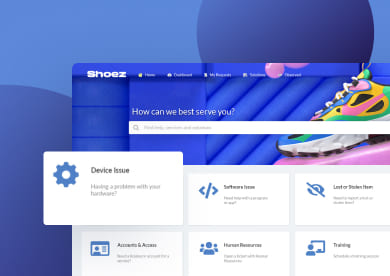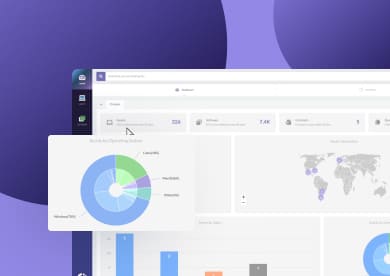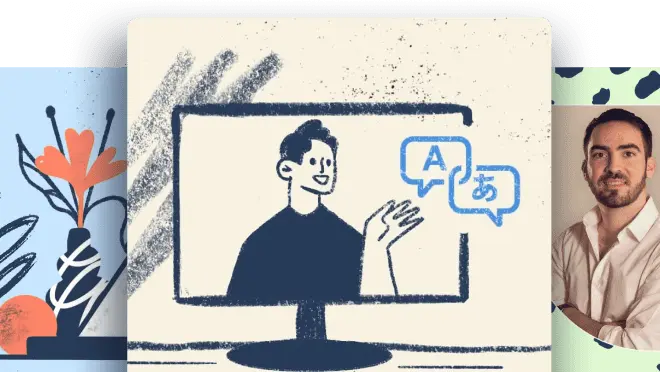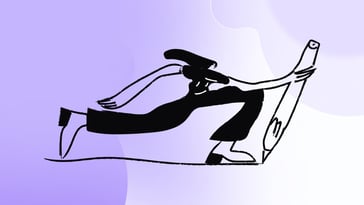The way you structure IT support tiers can make a measurable difference in response time, end-user satisfaction, and the workload your technical teams carry. While 5 tier support models exist, most day-to-day support activity happens in the first three. That’s why understanding the scope, purpose, and staff profiles for tiers 1, 2, and 3 is a good starting point for evaluating your service desk or planning improvements.
This article walks you through the main functions of the first three tiers of IT support, how to staff them, and when issues should move from one to the next. If you’re building a support model from scratch or trying to improve resolution times, this breakdown can help clarify what should be expected at each level.
What is a tier 1 help desk?
Tier 1 is the first line of live, person-to-person support in IT service delivery. It typically handles high-volume, low-complexity incidents, most of which are user-facing and don’t require administrative access or in-depth troubleshooting.
Analysts in tier 1 follow standardized procedures, often working with scripts or knowledge base articles, to solve routine issues. These include password resets, account unlocks, basic software questions, application errors, or hardware requests. They work within limited system access, so their role is primarily about rapid identification, triage, and resolution when possible.
When a request falls outside their scope (due to its complexity, access requirements, or urgency) they collect relevant details in a help desk platform and escalate it to tier 2. The goal is to resolve what they can at the first point of contact while acting as a gateway to higher tiers of support.
What does a tier 1 help desk do?
These are some of the most common tier 1 help desk tasks:
- Act as the single point of contact between the end-user and the IT department.
- Act as the "face" of IT.
- Log all incidents and service requests.
- Provide updates on tickets that are in flight.
- Provide closure details.
- It can be best placed to signpost the end-user to other resources.
Benefits of having a support tier 1
There are three basic benefits of having a support tier 1:
- Single point of contact - The tier 1 helpdesk retains ownership of the incident or request no matter what level it escalates to, meaning that nothing gets lost, ignored, or forgotten about.
- Human touch - Customer service skills are a crucial tenet of tier 1 support since this line in the support tier has the most direct customer contact.
- Act as a filter - The leading superpower associated with tier 1 technicians is that they're IT support generalists. They know the support basics of most (if not all) services used by the organization. This allows them to resolve most issues, freeing up tiers 2, 3, and 4 for more complicated faults.
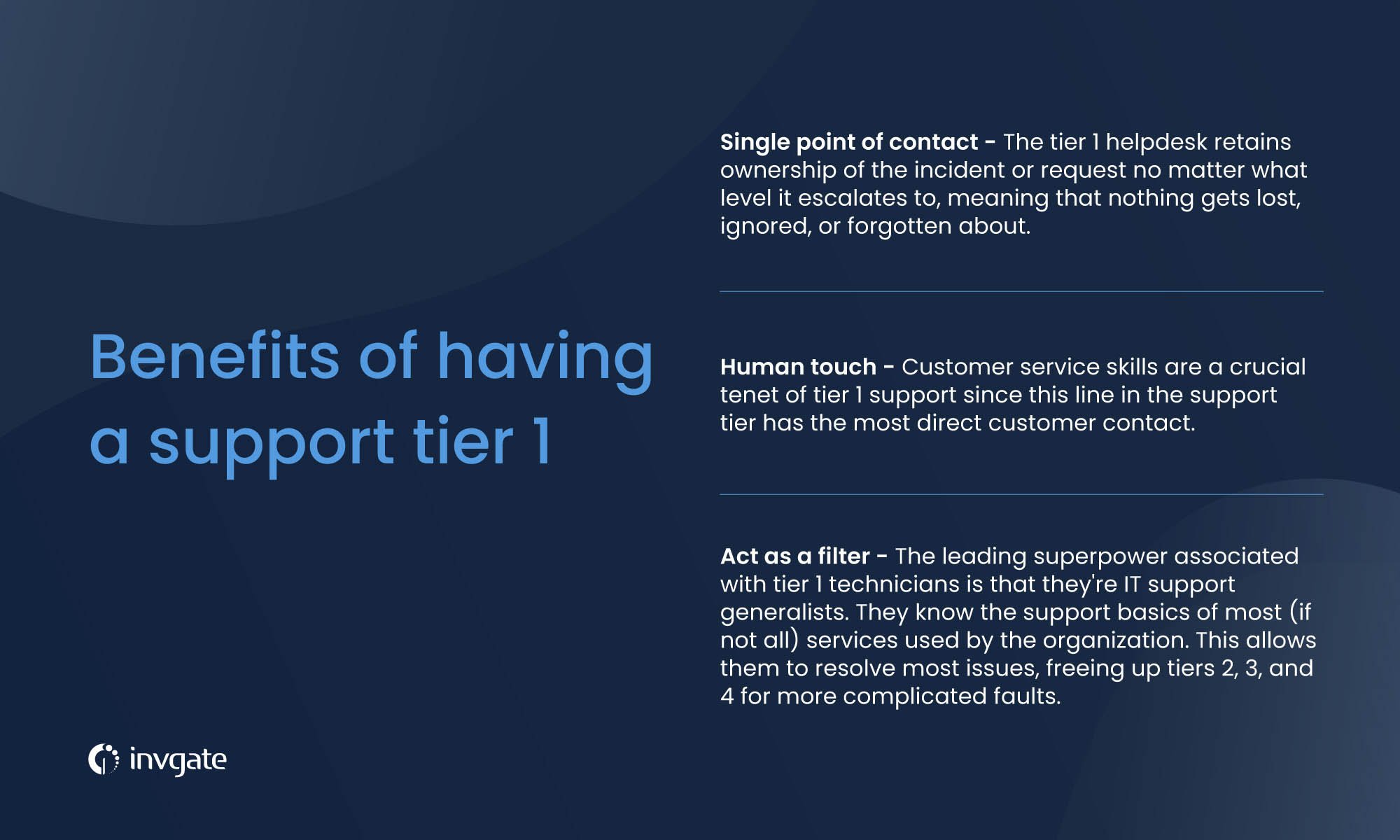
What makes a good tier 1 analyst?
Soft skills matter more than people think. Analysts at this level spend most of their time talking with non-technical users, so clarity, empathy, and patience go a long way. You can teach technical tasks, but interpersonal strengths are harder to instill later.
When onboarding new analysts, don’t skip training just because the team is short-staffed. Give them access to internal documentation, let them shadow more experienced agents, and allow time to build confidence before they handle tickets alone.
|
"[The hiring manager] asked me, ‘Why should I hire you when you have no IT experience?’, and I told him straight up, ‘I don’t have experience right now but I’ll have experience once you give me an opportunity to learn in the company. The reason you should hire me is because I have soft skills, and I’m good with people. (...) I could learn all the IT stuff, but you can’t teach soft skills’."
Kevin Apolinario
Senior Desktop Engineer at Confidential
Episode 22 of Ticket Volume
|
|
Help desk tier 1 skills
We already hinted at some of the abilities help desk tier 1 analysts should have, but here’s a more extensive list of required skills:
- Troubleshooting and technical support experience.
- Customer service.
- Empathy and being able to relate to the end-user.
- Listening.
- Strong communication skills.
- Teamwork (tier 1 environment will involve working closely with colleagues in other support teams as well as the helpdesk, often in a fast-paced and pressurized environment).
Common tier 1 support responsabilities
Tier 1 support is beneficial in the following situations:
- Logging urgent incidents and checking for major incidents.
- Troubleshooting routine incidents and fixing them at the first point of contact.
- Capturing further details and documenting recovery attempts before escalating to the next line of support when the issue can't be fixed at tier 1.
- Checking available software licenses as part of the software request process.
- Ordering new hardware or equipment.
- Workstation patch management.
- Updating the end-user.
What is tier 2 IT support?
Tier 2 support involves more technical depth. Analysts at this level are familiar with infrastructure, enterprise tools, and backend systems. They deal with escalated issues that need configuration changes, advanced troubleshooting, or deeper investigation.
Unlike tier 1, where quick resolution is the goal, tier 2 may take longer to fix a problem but should aim to resolve it fully without needing tier 3. Analysts in this group may have access to admin tools, logs, or system settings unavailable to tier 1.
Coomon tier 2 support responsibilities
- Reviewing application or system logs to identify underlying causes.
- Handling hardware configuration problems or software installation failures.
- Addressing account or permission issues that require elevated access.
- Handling recurring or major incidents.
- Providing advanced troubleshooting.
- Applying configuration changes.
- Coordinating with external vendors or support.
- Documenting fixes for tier 1 reference.
Because they work on fewer, more complex tickets, their workload tends to be more focused — but also higher-stakes.
What is tier 3 IT support?
Tier 3 is the final escalation point in most support models. It includes specialists, engineers, or vendor support teams. These are the people who maintain systems, design infrastructure, and handle fixes that require source-level access or development work.
Not every organization has an internal tier 3. In many cases, this role is handled by third parties — such as cloud providers or software vendors — especially when the issue involves bugs or backend updates.
Common tier 3 support responsibilities
- Investigating deep-rooted or structural issues.
- Coordinating long-term solutions or patches.
- Working on known errors or recurring problems.
- Collaborating with development or system admin teams.
- Recommending fixes that change system behavior.
Tickets should only reach tier 3 after a clear diagnostic path through tier 1 and 2. This minimizes unnecessary escalations and gives specialists more time to focus on root causes.

Best practices to optimize Tier 1, Tier 2, and Tier 3 IT support
Supporting users effectively means more than assigning tasks to each tier. To get real value from a multi-tiered model, teams need coordination, process clarity, and continuous learning. These practices can help improve how tier 1, 2, and 3 function individually and as part of a larger system.
1. Give tier 1 a strong foundation
Set clear boundaries for what tier 1 should handle and equip analysts with scripts, documentation, and training. A well-supported tier 1 team can resolve a high volume of requests quickly and confidently without overwhelming other teams. Track first contact resolution rates and give analysts time for skill development, not just ticket handling.
2. Make escalation clean and consistent
Tickets should only escalate when necessary, and when they do, the handoff should be complete. That means the issue is well documented, steps already taken are logged, and the tier 2 or 3 team gets the full picture without backtracking. Templates, standard operating procedures, and automation rules can help keep escalation paths predictable.
3. Let tier 2 focus on reducing recurrence
Tier 2 often sees patterns before anyone else. Analysts at this level should document fixes and submit them for inclusion in knowledge bases so tier 1 can reuse them. This also helps build a stronger feedback loop between tiers and reduces repeat escalations.
4. Use tier 3 to drive systemic improvements
Tier 3 is often responsible for deep fixes, long-term changes, or recurring problems. Track how often issues reach this level and why. If tier 3 analysts are frequently dealing with user-facing problems, consider whether knowledge gaps or tooling limitations in lower tiers are contributing.
5. Keep communication open across tiers
Encourage regular syncs or feedback loops between teams. Analysts in different tiers will have different perspectives, and bringing those together helps uncover where processes can improve or where documentation is falling short.
6. Monitor the right metrics
Track more than just resolution time. First contact resolution, escalation volume, ticket reassignment rates, and user satisfaction scores by tier can all point to areas that need adjustment. Avoid measuring performance purely on speed if it discourages thoroughness or collaboration.
In conclusion
Understanding how the first three tiers of IT support function (and what separates them) helps set realistic expectations and improve the way issues are handled. Tier 1 should focus on quick resolutions and user communication, tier 2 brings deeper troubleshooting and pattern recognition, and tier 3 steps in when fixes require infrastructure-level expertise.
Treating these tiers as part of a connected system, not isolated teams, helps move from reactive IT support to a more structured and predictable service experience, where users get faster answers, teams work more efficiently, and problems are resolved with fewer handoffs.
